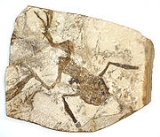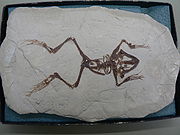
Palaeobatrachus
Encyclopedia
Palaeobatrachus was a primitive frog
from the Cretaceous
and Tertiary
period (130-5 million years ago), Central Europe. Although not closely related, it resembled the present day African clawed toad Xenopus
.
 Its skeletal remains are plentiful in freshwater sediments in western Bohemia
Its skeletal remains are plentiful in freshwater sediments in western Bohemia
, in Geiseltal (west Germany
) and in east Germany. They are sometimes preserved very well indeed, with impressions of internal organs, muscles, nerves, blood vessels and epidermis, and with traces of coloring. Tadpoles and eggs have also been found.
Palaeobatrachus had a relatively broad skull the shape of a Gothic arch. Its body was relatively large, ranging from 8 to 10 cm (3.1 to 3.9 in) in length, and the female was usually larger than the male (sexual dimorphism
).
These frogs lived permanently in water. Their bag-shaped lung
s, on the dorsal side of their body, enabled them to remain submerged for long periods. They inhabited through-drainage basins or swamps where brown coal deposits were formed. Like the African clawed toad, they probably lived on small crustacean
s, insect larvae and small fish and themselves provided sustenance for many other animals.
The climatic change at the beginning of the Pliocene
was a real catastrophe for Palaeobatrachus, which required warmth, and, being specialized, was unable to adapt itself to the altered conditions.
Frog
Frogs are amphibians in the order Anura , formerly referred to as Salientia . Most frogs are characterized by a short body, webbed digits , protruding eyes and the absence of a tail...
from the Cretaceous
Cretaceous
The Cretaceous , derived from the Latin "creta" , usually abbreviated K for its German translation Kreide , is a geologic period and system from circa to million years ago. In the geologic timescale, the Cretaceous follows the Jurassic period and is followed by the Paleogene period of the...
and Tertiary
Tertiary
The Tertiary is a deprecated term for a geologic period 65 million to 2.6 million years ago. The Tertiary covered the time span between the superseded Secondary period and the Quaternary...
period (130-5 million years ago), Central Europe. Although not closely related, it resembled the present day African clawed toad Xenopus
Xenopus
Xenopus is a genus of highly aquatic frogs native to Sub-Saharan Africa. There are 19 species in the Xenopus genus...
.

Bohemia
Bohemia is a historical region in central Europe, occupying the western two-thirds of the traditional Czech Lands. It is located in the contemporary Czech Republic with its capital in Prague...
, in Geiseltal (west Germany
Germany
Germany , officially the Federal Republic of Germany , is a federal parliamentary republic in Europe. The country consists of 16 states while the capital and largest city is Berlin. Germany covers an area of 357,021 km2 and has a largely temperate seasonal climate...
) and in east Germany. They are sometimes preserved very well indeed, with impressions of internal organs, muscles, nerves, blood vessels and epidermis, and with traces of coloring. Tadpoles and eggs have also been found.
Palaeobatrachus had a relatively broad skull the shape of a Gothic arch. Its body was relatively large, ranging from 8 to 10 cm (3.1 to 3.9 in) in length, and the female was usually larger than the male (sexual dimorphism
Sexual dimorphism
Sexual dimorphism is a phenotypic difference between males and females of the same species. Examples of such differences include differences in morphology, ornamentation, and behavior.-Examples:-Ornamentation / coloration:...
).
These frogs lived permanently in water. Their bag-shaped lung
Lung
The lung is the essential respiration organ in many air-breathing animals, including most tetrapods, a few fish and a few snails. In mammals and the more complex life forms, the two lungs are located near the backbone on either side of the heart...
s, on the dorsal side of their body, enabled them to remain submerged for long periods. They inhabited through-drainage basins or swamps where brown coal deposits were formed. Like the African clawed toad, they probably lived on small crustacean
Crustacean
Crustaceans form a very large group of arthropods, usually treated as a subphylum, which includes such familiar animals as crabs, lobsters, crayfish, shrimp, krill and barnacles. The 50,000 described species range in size from Stygotantulus stocki at , to the Japanese spider crab with a leg span...
s, insect larvae and small fish and themselves provided sustenance for many other animals.
The climatic change at the beginning of the Pliocene
Pliocene
The Pliocene Epoch is the period in the geologic timescale that extends from 5.332 million to 2.588 million years before present. It is the second and youngest epoch of the Neogene Period in the Cenozoic Era. The Pliocene follows the Miocene Epoch and is followed by the Pleistocene Epoch...
was a real catastrophe for Palaeobatrachus, which required warmth, and, being specialized, was unable to adapt itself to the altered conditions.

